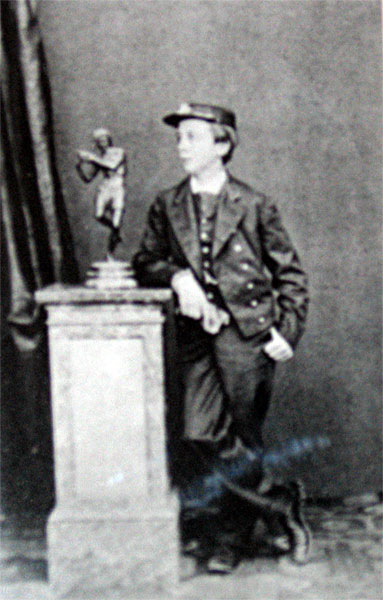His concern over his son's [i. e., Alfred's] scarlet fever made it imperative to stay in London with Catherine, who was now heavily pregnant, and so he rented the temporary accommodation in Chester Place until the end of June [1847]. It was here, in the small street off Regent's Street and only a short distance from the Polygon as well as other haunts of Dickens's childhood, that Sydney Smith Haldimand Dickens was born. The seventh child. [Ackroyd 528]
Sydney Smith Haldimand Dickens, "The Ocean Spectre" and "Little Admiral" (18 April 1847 — 2 May 1872)

Sydney Smith Haldimand Dickens in about 1860. Source: Wikipedia (public domain).
Sydney Smith Haldimand Dickens, the seventh child and fifth son of Charles and Catherine Dickens, was named after a member of the Haldimand family noted for his charitable works, William Haldimand (1764-1862). He was the heir of the illustrious Sir Frederick Haldimand, a Swiss officer who rose to prominence in the British army during the Seven Years War and became Governor of Quebec. Haldimand was chosen as one godfather for the child; the boy's other godfather, Henry Porter Smith (1797-1880), was a business associate of Dickens — an actuary for the Eagle Life Assurance Company.
A likeness reproduced by Lucinda Dickens Hawksley helps to explain the first of Sydney's nicknames, showing him with disproportionately large eyes: "He was given the name of the Ocean Spectre, from a strange little weird, yet most attractive, look in his large wondering eyes." Hawksley has described him as "a strange-looking child, with his too-slender frame." See also the photographic portrait of him as a midshipman on page 34 of Charles Dickens: Dickens' Bicentenary 1812-2012. In fact, Sydney was the smallest of the Dickens children to survive infancy, and even in adulthood would stand only five feet tall.
Sydney, like his brothers Frank, Alfred and Henry, was sent abroad to be educated at Mr. Gibson's boarding school in Boulogne-sur-Mer. At thirteen, the boy entered the naval college in Southsea; and, upon graduation, joined the Royal Navy with a promotion to the rank of midshipman on 7 March 1862. He was, unfortunately, another reckless and improvident Dickens son. But despite his debts, Charles Dickens praised the boy as a "born little sailor" (Ackroyd 878).
However, he remained somewhat frail; the family story is that he contracted a severe fever. While serving as a lieutenant on board H. M. S. Topaze, he had to be invalided out as a result of poor health on 22 April 1872. He was transferred to the P&O steamer Malta, on board of which he died from a sharp attack of bronchitis in the Indian Ocean — and that is where he was buried, aged twenty-five, two years after his father's death. His was, as Peter Ackroyd remarks, "one of the many foreshortened lives of the children" (604). The inscription on Sydney's memorial in Highgate reads: "Lieutenant Sydney Smith Haddington [sic], fifth son of Charles and Catherine Dickens. Born 18th. April 1847, died and was buried at sea 2nd. May 1872."
Related Materials
- Catherine Dickens (née Hogarth), 1816-79: Dickens's Wife and Travelling Companion
- A Chronology of Dickens's Life
- The Children of Charles Dickens and Catherine Hogarth Dickens, 1837-52
- Major Biographies of Dickens — a Critical Overview
- Where the Dickens: A Chronology of the Various Residences of Charles Dickens, 1812-1870
Bibliography
Ackroyd, Peter. Dickens. London: Sinclair-Stevenson, 1990.
Davis, Paul. Charles Dickens A to Z: The Essential Reference to His Life and Work. New York: Facts On File, 1999.
Hawksley, Lucinda Dickens. Charles Dickens. Dickens' Bicentenary 1812-2012. San Rafael, California: Insight, in association with the Charles Dickens Museum, London, 2012.
Schlicke, Paul (ed.). The Oxford Readers's Companion to Dickens. Oxford: Oxford U. P., 1999.
Slater, Michael. Charles Dickens. New Haven and London: Yale University Press, 2009.
Tomalin, Claire. Charles Dickens: A Life. New York: Penguin, 2011.
Witt, Emily. "Daddy Issues: On the Worthless Brood of Charles Dickens. Review of Great Expectations: The Sons and Daughters of Charles Dickens (FSG, 256 pp., $25) by Robert Gottlieb". Online version available from The Observer. Web. 12/04/12.
Created 16 September 2019